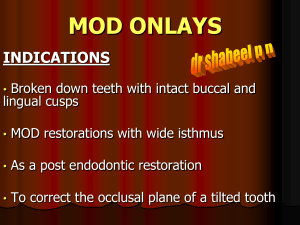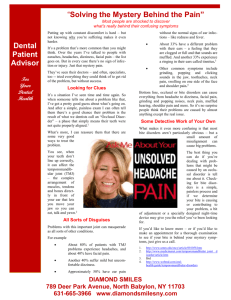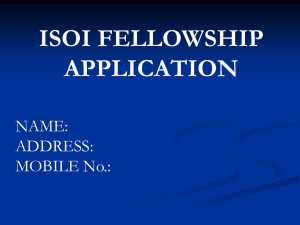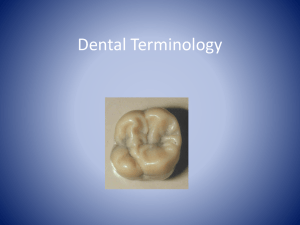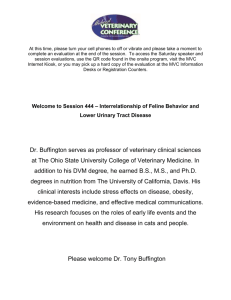View/Open
advertisement
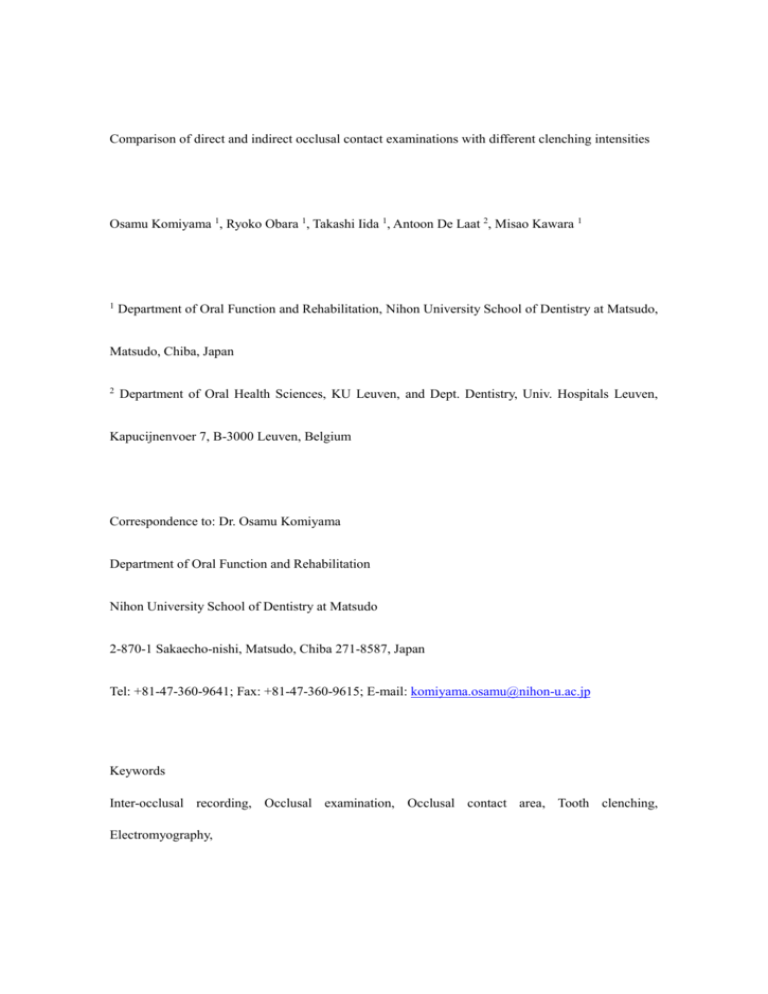
Comparison of direct and indirect occlusal contact examinations with different clenching intensities Osamu Komiyama 1, Ryoko Obara 1, Takashi Iida 1, Antoon De Laat 2, Misao Kawara 1 1 Department of Oral Function and Rehabilitation, Nihon University School of Dentistry at Matsudo, Matsudo, Chiba, Japan 2 Department of Oral Health Sciences, KU Leuven, and Dept. Dentistry, Univ. Hospitals Leuven, Kapucijnenvoer 7, B-3000 Leuven, Belgium Correspondence to: Dr. Osamu Komiyama Department of Oral Function and Rehabilitation Nihon University School of Dentistry at Matsudo 2-870-1 Sakaecho-nishi, Matsudo, Chiba 271-8587, Japan Tel: +81-47-360-9641; Fax: +81-47-360-9615; E-mail: komiyama.osamu@nihon-u.ac.jp Keywords Inter-occlusal recording, Occlusal examination, Occlusal contact area, Tooth clenching, Electromyography, Abstract The aims of this study were to examine the change of occlusal contact area following the increment of clenching intensity in normal subjects and compare intra-oral direct and indirect occlusal contact examinations using dental casts. For measuring the clenching activity masseteric electromyography was used, while occlusal contact area was evaluated with silicone materials. Participants were 7 men and 5 women with no more than one missing tooth per quadrant and no pain in the head and neck region. As a baseline measurement, participants performed a force control task during occlusal contact examinations. During the task, intercuspal position was maintained with minimal force, 20% maximum voluntary contraction (MVC) and 40% MVC using visual feedback. Three types of occlusal contact examinations were performed with the aid of blue silicone material: 1) intra-oral direct occlusal contact examination (DE), 2) indirect occlusal contact examination with dental casts using conventional impression method (IEC), and 3) indirect occlusal contact examination with dental casts using occlusal impression method (IEO). The differences in occlusal contact areas among the three tasks and among the three examination methods were analyzed using the Kruskal-Wallis ANOVA, followed by a post hoc Bonferroni tests to compensate for multiple comparisons. Total occlusal contact area during DE and IEO significantly increased from baseline to 20% MVC, and from baseline to 40% MVC, but not during IEC. Total occlusal contact area during DE in all tooth clenching conditions was significantly larger compared to IEO and IEC (P < 0.05). At 40% MVC, total occlusal contact area during IEO was significantly larger than during IEC (P < 0.05). These findings suggest that indirect occlusal contact examinations may not accurately reflect the intra-oral occlusal condition. If the intra-oral condition is reproduced using dental casts, , these findings also suggest the occlusal impression method was more accurate compared to the conventional impression method. Introduction A variety of occlusal examination methods are currently employed (1-3). For intra-oral occlusal examination, the occlusal contact area of a patient provides valuable information for oral disease diagnosis, treatment, and prognosis (4–7). We have shown that registration of occlusal contact during intercuspation using silicone material was not stable at 10% maximum voluntary contraction (MVC), but was stable at 20% MVC and continued to be at 40% MVC (8). Therefore, adequate clenching force may be required to register the appropriate occlusal contact, and proper verbal instructions would help to take a stable occlusal recording of the natural dentition (9). On the other hand, since there is multidirectional visibility and possible simulation for occlusal treatment, occlusal examination is also performed using an articulator with dental arch casts (10, 11). However, no studies have investigated the differences in occlusal contact area between the intra-oral direct examination and indirect examination using dental casts. Prosthodontic procedures that require the mounting of casts on articulators require accurate interocclusal registration (12-14). According to previous studies, the basic principal approach should be to make the interocclusal record at the correct intercuspal position, choosing an accurate, and dimensionally stable recording material (15, 16). Many factors influence the accuracy of an interocclusal record, such as the materials used, intercuspal position, or retruded contact position, and other clinical variations that are involved in the recording procedure (17). Wax and silicone are currently the most commonly used recording materials (18). However, for interocclusal registration using these materials, no preferred method has been established and no appropriate comparison of occlusal contact between intra-oral conditions and dental arch casts mounted on articulators has been performed to our knowledge. Although some reports have evaluated the effectiveness of the occlusal impression method in reproducing the occlusal contact for prosthodontic procedures (19-21), the differences in occlusal contact recorded by conventional impression and occlusal impression have not been studied. The present study aimed to examine the change of occlusal contact area following the increment of clenching intensity using silicone materials and electromyography (EMG) in normal subjects and compare direct intra-oral examination with indirect examination using dental casts mounted by means of two impression methods. The obtained results may be helpful when examining occlusal-related disorders and for making accurate interocclusal recordings during prosthodontic treatment. Materials and Methods Subjects Subjects were recruited from among our university students and staff. All were Japanese, had intact dentitions with no more than one missing tooth per quadrant (excluding third molars) and no pain in the head and neck region suggestive of temporomandibular disorders (TMD) as defined by the Research Diagnostic Criteria for TMD (22). Subjects were excluded if they were currently taking medication or were receiving other treatment that could not be interrupted for the study, if general health problems (e.g., neurological disorders) or periodontal disease were present, or had a history of drug abuse. Participants were 7 men and 5 women (aged 24 to 29 years, mean age ± SD: 26.6 ± 1.8 years). Each subject was informed about the study in a standardized way and signed an informed consent form before participating. The Institutional Ethics Committee approved the study (EC11-014), and all procedures were performed in accordance with the guidelines set out by the Declaration of Helsinki. Force control during occlusal contact examination Force control during occlusal contact examination was performed as in our previous study (8). During the examination, each subject was comfortably seated upright in a dental chair with the head supported. The skin over the recording positions was cleaned with alcohol. The central part of the masseter muscle (MM) midway between the upper and lower borders, and 1 cm posterior to the anterior border was detected by manual palpation. Surface electrodes (NM319Y, Nihon Kohden, Tokyo, Japan) were placed 15 mm apart along the muscle belly in the left and right masseter muscle and a common electrode was attached to the left wrist. The EMG signal was amplified 500 to 5000 times and sampled (1500 Hz) using a Muscle Balance Monitor (GC, Tokyo, Japan) applied to control masseter muscle activity as visual feedback. At the start of the experimental session, three 3-s recordings of the maximum voluntary contraction (MVC) were performed while the participant clenched in the maximum intercuspal position and the mean value of the three MVC recordings was calculated. Subjects performed three tasks, :baseline, 20% MVC, and 40% MVC, with visual feedback on a screen. For the baseline measurement, the following instructions were given to the subjects: “Please close your mouth and touch the opposing teeth with minimal force”. The intercuspal position after habitual closure of the mouth was maintained with minimal force using visual feedback and occlusal contact was recorded. The occlusal contact was also recorded at 20% MVC and 40% MVC using visual feedback. The range of error for the target MVC was inspected visually by the examiner. The sequence of measurement with baseline, 20% MVC, and 40% MVC was randomized. Between each clench, an interval of at least 10 min. was imposed to avoid fatigue of the masseter muscle. During these tasks (baseline, 20% MVC, 40% MVC, 100% MVC), masseter muscle activities from both sides were also measured using a multi-telemeter system (WEB-5000, Nihon Kohden, Tokyo, Japan) with the high-cut frequency turned off, a time constant of 0.03 seconds, and sensitivity of 0.5 mv/diV. EMG signals were recorded at a sampling frequency of 1 kHz and transferred to wave analysis software (Powerlab, AD Instruments, Sydney, Australia). Direct occlusal contact examination (DE) As for direct occlusal contact examination, the occlusal recording was performed for each task (baseline, 20%MVC, and 40%MVC) with the aid of blue silicone material (Blue Silicone, GC, Tokyo, Japan). An automatic mixing cartridge of silicone materials was injected onto the occlusal surfaces of mandibular teeth. The subjects were asked to close their mouth and clench vertically at each task level for 1 min until the silicone material had completely set. The record was removed from their mouths carefully and image analysis was performed for three record preparations (baseline, 20%MVC, and 40%MVC). Indirect occlusal contact examination with conventional impression method (IEC) Impressions of the maxillary and mandibular teeth were recorded for each subject using a custom tray made using self-cured acrylic resin (OSTRON II®, GC, Tokyo, Japan) and vinyl polysiloxane impression material (Exahiflex®, GC, Tokyo, Japan). Full-arch dental casts were prepared from these impressions using dental stone (New Fujirock®, GC, Tokyo, Japan) following the manufacturer’s instructions. The occlusal surface of each cast was examined for defects and positive imperfections were removed. The occlusal registration was prepared with each task level (baseline, 20%MVC, and 40%MVC) for 1 min until the silicone bite registration material had completely set (Correct Quick® Bite, Pentron, CA, USA). The maxillary cast was mounted on a Whip-Mix semi-adjustable articulator (Model 8500, Whip Mix Corp., Ky, USA) using dental plaster. The lower cast was articulated to the upper using the silicone registration with each task and mounted. The incisal guidepin was disengaged from the incisal guidance table, and occlusal contact examination was done with the aid of blue silicone material (Blue Silicone, GC, Tokyo, Japan). An automatic mixing cartridge of silicone materials was used and injected onto the occlusal surfaces of lower cast. The maxillary cast was placed by hand to maximal intercuspal position and 1kg weight was held for 1 min until the silicone material had completely set (23). The record was removed from the cast carefully and image analysis was performed in different mounting of casts for three record preparations (baseline, 20%MVC, and 40%MVC). Indirect occlusal contact examination with occlusal impression method (IEO) A large-sized dual-arch impression tray (TRIPLE TRAY®, Premier Dental Products Co., PA, USA) was used for occlusal impression. The tray design had a 'U'-shaped frame and a piece of fabric mesh. The mesh connects the sides of the tray in the bucco-lingual dimension and allows holding the impression materials on both sides to make maxillary and mandibular impressions together. Vinyl polysiloxane impression material (EXAHIFLEX®, GC, Tokyo, Japan) was used for taking occlusal impressions in maxillary and mandibular teeth simultaneously. While taking the impression, the subjects were asked to close their mouth and to clench vertically at each task level (baseline, 20%MVC, and 40%MVC) for 3 min until the impression material had completely set. The dual-arch impression was removed from mouth. First, the mandibular impression was poured using dental stone (New Fujirock®, GC, Tokyo, Japan). After the stone had initially set, the maxillary impression was poured in dental stone. Without separating the casts, maxillary and mandibular casts were mounted to a Whip-Mix semi-adjustable articulator (Model 8500, Whip Mix Corp., Ky, USA), with the dual-arch impression tray in position. Occlusal contact examination was done in the same way as the conventional impression method (23). Three occlusal contact records were obtained in different mountings of casts using occlusal impression during three tasks (baseline, 20%MVC, and 40%MVC). Analysis of occlusal contact area An occlusal analytic device (Bite-eye BE-I, GC, Tokyo, Japan) was used for analysis of the occlusal contact area as previously reported (8). In this study, silicone occlusal records were analyzed as the thickness of silicone material was less than 30 µm (0-29 µm) for occlusal contact. Since a previous study showed different tendencies in the anterior and posterior parts of the dental arch (8), the anterior part (from canine to canine), and the left and right posterior parts (premolar and molar teeth), the occlusal contact areas in these three parts of the dental arch and total arch were analyzed separately. Statistical analysis The relative ratio from the MM EMG activities during all tasks (Baseline, 20%MVC, and 40%MVC) was analyzed using the Kruskal-Wallis ANOVA. In occlusal contact area analysis, the occlusal contact areas during all tasks (Baseline, 20%MVC, and 40%MVC) and all examination methods (DE, IEC, and IEO) were analyzed using the Kruskal-Wallis ANOVA. When appropriate, the ANOVAs were followed by a post hoc Bonferroni test to compensate for multiple comparisons. The level of statistical significance was set at P < 0.05. Mean values and 95% confidence intervals are presented in the text. All analyses were performed using the SPSS software package (SPSS 12.0 for Windows; SPSS Inc., Chicago, IL, USA). Results EMG measurement Table 1 shows the mean relative ratio of muscle activities in the masseter muscle from both sides during DE, IEC and IEO with each tooth clenching condition. Mean relative ratio of masseter muscle activities at baseline during DE, IEC and IEO were 7.8 ± 3.5 %, 10.3 ± 9.5 % and 12.8 ± 4.9 %, respectively. There was no significant difference among the occlusal contact examination methods at baseline. Mean relative ratios at 20% MVC during DE, IEC and IEO were 19.3 ± 5.0 %, 21.0 ± 8.0 % and 19.6 ± 4.8 %, respectively, and those in 40% MVC during DE, IEC and IEO were 37.0 ± 10.1 %, 37.1 ± 4.5 % and 38.7 ± 6.5 %, respectively. There was also no significant difference beween the occlusal contact examination methods at 20% and 40% MVC. Mean relative ratios of masseter muscle activities at baseline in all occlusal contact examination methods were significantly lower compared to 20% and 40% MVC (P < 0.05), and there was a significant difference between 20% MVC and 40% MVC (P < 0.05). Occlusal contact area Table 2 shows the mean occlusal contact area at the left posterior, right posterior, anterior regions, and total area during DE, IEC and IEO with each tooth clenching condition. The occlusal contact area in the anterior part was smaller than that in the posterior part, and there was no significant increase following the increment of increasing tooth clenching condition during DE, IEC and IEO. The occlusal contact area in the posterior part and total part increased with increasing tooth clenching intensity during DE and IEO, but not in IEC. There was a significant increase of the occlusal contact area during DE in the posterior and total part from baseline to 20% MVC, and from baseline to 40% MVC (P < 0.05). There was also a significant increase of the occlusal contact area during IEO in the posterior and total part from baseline to 40% MVC (P < 0.05). Figure 1 shows the mean and standard error of the mean for the total occlusal contact area during DE, IEC and IEO with each tooth clenching condition. Total occlusal contact area during DE and IEO were significantly increased from baseline to 20% MVC, and from baseline to 40% MVC, but not during IEC. Total occlusal contact area during DE in all tooth clenching conditions was significantly larger compared to IEO and IEC (P < 0.05). At 40% MVC, total occlusal contact area during IEO was significantly larger compared to IEC (P < 0.05). Discussion The present findings demonstrated that occlusal contact area significantly increased from baseline to 20%MVC, and it stabilized to 40%MVC during DE, which confirms the results of our previous study (8). Furthermore, occlusal contact area tended to be different between direct and indirect occlusal contact examination. Both of indirect occlusal contact examinations with dental casts showed quite lower values compared to intra-oral direct examination. The occlusal contact area with IEO also significantly increased from baseline to 20%MVC, and it stabilized to 40% MVC, but not with IEC. In the anterior part of the dental arch, there was no increase in the occlusal contact area along with changes in the tooth clenching intensity; this was only seen at the posterior part of the dental arch. Regarding the increase in occlusal contact area, Hidaka et al. (24) described that physiological tooth mobility (25) and dental arch deformation during tooth clenching (26) are the most likely explanations for such a change, where the applied force to the teeth would be well balanced from a mechanical standpoint in the stomatognathic system. This increase in occlusal contact area with changes in tooth clenching intensity would also be helpful in preventing excessive pressure to certain regions of teeth. In addition, it was shown that the relative occlusal force ratio at the second molar increased with increasing tooth clenching conditions, while that of the canine decreased (27). Therefore, these results suggest that the contact distribution was altered by the shifts of regional occlusal loads. Non-rigidity of the bone and periodontal ligament allows minor tooth movement during forceful tooth clenching. When greater force is applied between antagonistic teeth, more tooth movement would occur in the periodontal space, resulting in closer intercuspation and decreased space between antagonistic teeth. This may be a possible explanation for the significant increase in the occlusal contact area found in the posterior region. Surprisingly, the indirect occlusal contact area examined in the articulator with dental casts was significantly lower compared to the intra-oral direct occlusal contact examination : it was almost 5 to 10 times higher in DE (Table 2). There were some reports regarding the accuracy of occlusal contact with dental casts in articulator using various inter-occlusal recording. Millstein et.al evaluated the accuracy of casts made from stock tray and custom tray impressions and the results indicated that all casts distort but that impressions made from custom trays were more accurate and consistent in reproduction than were stock tray impressions (28). Eriksson et.al reported that clinical variation seems to dominate the variation in positions of mounting casts when making interocclusal records, rather than mandibular position or the recording materials used, and a dentist who makes one single interocclusal record cannot presume that it will reproduce the interocclusal relationship intended (29). Janson suggested that overall reproducibility of tooth contact was observed more frequently in the articulator than in the mouth, however, when subjects were classified by the extent of occlusal interference, the findings of the clinical analysis seemed to be more reproducible than those recorded by means of the articulator (30). In recent years, no studies have compared between direct and indirect occlusal contact examination. Some problems exist when examining and treating the occlusal contact with dental casts as mentioned above, and precision is required for intra-oral examination and treatment procedure. As shown Fig. 1, significantly different tendencies were found in IEC and IEO. Wöstmann et al. suggested that the inlay preparation was more difficult to reproduce with dual-arch trays. Therefore, it can be concluded that the accuracy obtainable with nonrigid dual-arch trays is comparable to impressions taken from full-arch trays (31). Parker et al. reported that the quadrant dual-arch impression technique produced mounted casts with significantly more accurate maximal intercuspal relationships than mounted casts from full-arch impressions (23). Ceyhan et al. showed that the dimensions of working dies from a custom tray impression did not differ significantly from those created with dual arch trays, but working dies from a plastic dual-arch tray were more accurate buccolingually than those from metal dual-arch trays (32). In this study, we used plastic dual-arch impression trays. This may not be suitable for the fabrication of prostheses, but could replicate a good occlusal contact compared to conventional impression methods. Suzuki et al. fabricated fixed implant prostheses using the functional bite impression technique, and suggested that a precise prosthesis could be produced by completing simultaneously the maxillomandibular registration, impression and function prostheses form (33). Since the occlusal impression should reproduce the intra-oral condition precisely, it also suggested that replication of an intra-oral occlusal contact by dental casts was a more accurate occlusal impression method compared to the conventional impression method. Conclusion This study suggested that indirect occlusal contact examination may not reflect the accurate intra-oral occlusal condition such as occlusal contact area. Therefore, indirect occlusal contact examination may be limited to use of macro-viewpoints such as multidirectional checking of tooth contour and anterior-posterior/superior-inferior position of teeth. Furthermore, since occlusal rehabilitation should be managed using accurate and reproducible procedures that are applied with strong clinical skills to reduce unnecessary technical failures and/or the requirement for compensatory adjustments, attaining profound prosthodontic knowledge and/or skills will be necessary for occlusal treatment. Conflict of interest The authors declare that they have no competing financial interests. Acknowledgments This study was supported by Grants-in-Aid for Scientific Research (C 26462959 and C xxxxxxx) from the Japanese Society for the Promotion of Science. References 1. Kerstein RB, Lowe M, Harty M, Radke J. A force reproduction analysis of two recording sensors of a computerized occlusal analysis system. Cranio. 2006;24:15–24. 2. Kalachev YS, Lordanov PL, Chaprashikian OG, Manohin E. Measurement of the magnitude of the occlusal forces during articulation. Folia Med (Plovdiv). 2001;43:97–100. 3. Sultana MH, Yamada K, Hanada K. Changes in occlusal force and occlusal contact area after active orthodontic treatment: a pilot study using pressure sensitive sheets. J Oral Rehabil. 2002;29:484–491. 4. Sato S, Ohta M, Sawatari M, Kawamura H, Motegi K. Occlusal contact area, occlusal pressure, bite force, and masticatory efficiency in patients with anterior disc displacement of the temporomandibular joint. J Oral Rehabil. 1999;26:906–911. 5. Raadsheer MC, van Eijden TM, van Ginkel FC, Prahl-Andersen B. Contribution of jaw muscle size and craniofacial morphology to human bite force magnitude. J Dent Res. 1999;78:31–42. 6. Matsui Y, Ohno K, Michi K, Suzuki Y, Yamagata K. A computerized method for evaluating balance of occlusal load. J Oral Rehabil. 1996;23:530–535. 7. Hattori Y, Satoh C, Seki S, Watanabe Y, Ogino Y, Watanabe M. Occlusal and TMJ Loads in subjects with experimentally shortened dental arches. J Dent Res. 2003;82:532–536. 8. Obara R, Komiyama O, Iida T, De Laat A, Kawara M. Influence of the thickness of silicone registration material as a means for occlusal contact examination--an explorative study with different tooth clenching intensities. J Oral Rehabil. 2013;40:834-43. 9. Obara R, Komiyama O, Iida T, Asano T, De Laat A, Kawara M. Influence of different narrative instructions to record the occlusal contact with silicone registration materials. J Oral Rehabil. 2014 ;41:218-25. 10. Boyarsky HP, Loos LG, Leknius C. Occlusal refinement of mounted casts before crown fabrication to decrease clinical time required to adjust occlusion. J Prosthet Dent. 1999:82:591-4. 11. Meng JC, Nagy WW, Wirth CG, Buschang PH. The effect of equilibrating mounted dental stone casts on the occlusal harmony of cast metal complete crowns. J Prosthet Dent. 2010:104:122-32. 12. Walls AW, Wassell RW, Steele JG. A comparison of two methods for locating the intercuspal position (ICP) whilst mounting casts on an articulator. J Oral Rehabil. 1991;18:43-48. 13. Breeding LC, Dixon DL, Kinderknecht KE. Accuracy of three interocclusal recording materials used to mount a working cast. J Prosthet Dent. 1994;71:265-270 14. Koyano K, Tsukiyama Y, Kuwatsuru R. Rehabilitation of occlusion - science or art? J Oral Rehabil. 2012;39:513-21. 15. Warren K, Capp N, A review of principles and techniques for making interocclusal records for mounting working casts. Int J Prosthodont 1990; 3: 341-348. 16. Lassila V, McCabe JF. Properties of interocclusal registration materials. J Prosthet Dent. 1985;53:100-104. 17. Ockert-Eriksson G, Eriksson A, Lockowandt P, Eriksson O. Materials for interocclusal records and their ability to reprocduce a 3-dimensional jaw relationship. Int L Prosthodont 2000; 13: 152-158. 18. Eriksson A, Ockert-Eriksson G, Lockowandt P, Eriksson O. Clinical factors and clinical variation influencing the reproducibility of interocclusal recording methods. Br Dent J 2002; 192: 395-400. 19. Larson TD, Nielsen MA, Brackett WW. The accuracy of dual-arch impressions: a pilot study. J Prosthet Dent. 2002 Jun;87(6):625-7. 20. Wöstmann B, Rehmann P, Balkenhol M. Accuracy of impressions obtained with dual-arch trays. Int J Prosthodont. 2009;22(2):158-60. 21. Reddy JM1, Prashanti E, Kumar GV, Suresh Sajjan MC, Mathew X. A comparative study of inter-abutment distance of dies made from full arch dual-arch impression trays with those made from full arch stock trays: an in vitro study. Indian J Dent Res. 2009;20(4):412-7. 22. Dworkin SF, LeResch L edited. Research diagnostic criteria for temporomandibular disorders. Review, criteria, examination and specifications, critique. J Orofac Pain. 1992;6:301–355. 23. Parker MH, Cameron SM, Hughbanks JC, Reid DE. Comparison of occlusal contacts in maximum intercuspation for two impression techniques. J Prosthet Dent. 1997: 78:255-9. 24. Hidaka O, Iwasaki M, Saito M, Morimoto T. Influence of clenching intensity on bite force balance, occlusal contact area, and average bite pressure. J Dent Res. 1999;78:1336–1344. 25. Mühlemann, HR. Tooth mobility: a review of clinical aspects and research findings. J Periodontol. 1967;38:686–713. 26. Korioth TW, Hannam AG. Deformation of the human mandible during simulated tooth clenching. J Dent Res. 1994;73:56–66. 27. Kikuchi M, Korioth TW, Hannam AG. The association among occlusal contacts, clenching effort, and bite force distribution in man. J Dent Res. 1997;76:1316–1325. 28. Millstein P, Maya A, Segura C. Determining the accuracy of stock and custom tray impression/casts. J Oral Rehabil. 1998: 25:645-8. 29. Eriksson A, Ockert-Eriksson G, Lockowandt P, Eriksson O. Clinical factors and clinical variation influencing the reproducibility of interocclusal recording methods. Br Dent J. 2002;192:395-400. 30. Janson M. Reproducibility of occlusal findings. A comparison between clinical and articulator analyses. Acta Odontol Scand. 1986 ;44:95-9. 31. Wöstmann B, Rehmann P, Balkenhol M. Accuracy of impressions obtained with dual-arch trays. Int J Prosthodont. 2009;22:158-60. 32. Ceyhan JA, Johnson GH, Lepe X, Phillips KM. A clinical study comparing the three-dimensional accuracy of a working die generated from two dual-arch trays and a complete-arch custom tray. J Prosthet Dent. 2003 ;90(3):228-34. 33. Suzuki Y, Shimpo H, Ohkubo C, Kurtz KS. Fabrication of fixed implant prostheses using function bite impression technique (FBI technique). J Prosthodont Res. 2012;56(4):293-6. Table 1. Mean values of relative ratio (% maximum voluntary contraction: MVC) from masseter muscle EMG during each tooth clenching condition Occlusal contact examination methods Direct occlusal contact examination Indirect occlusal contact examination with conventional impression method Indirect occlusal contact examination with occlusal impression method Tooth Clenching Condition Baseline 20% MVC 40% MVC 7.8 ± 3.5 19.3 ± 5.0* 37.0 ± 10.1† 10.3 ± 9.5 21.0 ± 8.0* 37.1 ± 4.5† 12.8 ± 4.9 19.6 ± 4.8* 38.7 ± 6.5† Values of relative ratio are expressed as the means ± standard deviation. *: P < 0.05 when compared to Baseline. †: P < 0.05 when compared to Baseline and 20% MVC Table 2. Descriptive data for measurement of occlusal contact area (mm2) Occlusal contact examination Part of dental Tooth Clenching Condition methods arch Baseline 20% MVC 40% MVC Left posterior 12.0 ± 7.6 19.3 ± 11.1* 20.6 ± 10.9* Direct occlusal contact Right posterior 11.0 ± 7.6 19.8 ± 11.4* 21.0±11.1* examination Anterior 2.8 ± 2.8 4.7 ± 4.0 4.6±3.7 Total 25.7 ± 13.5 43.8 ± 23.4* 46.2 ± 22.3* Indirect occlusal contact Left posterior 1.2 ± 2.0 2.7 ± 3.1 2.7 ± 3.3 examination with Right posterior 1.6 ± 1.9 2.0 ± 2.5 0.7 ± 0.7 conventional impression Anterior 0.7 ± 1.2 1.5 ± 2.0 1.4 ± 1.9 method Total 3.4 ± 2.3 6.2 ± 2.3 4.8 ± 2.3 Left posterior 2.5 ± 2.8 6.0 ± 6.6 8.5 ± 7.1* Right posterior 2.8 ± 4.6 5.9 ± 6.9 6.4 ± 3.9* Anterior 0.6 ± 0.7 1.4 ± 1.9 1.3 ± 2.0 Total 5.8 ± 7.0 13.3 ± 14.9* 16.2 ± 11.6* Indirect occlusal contact examination with occlusal impression method Values are expressed as the means ± standard deviation. MVC: maximum voluntary contraction, *: P < 0.05 when compared to Baseline Figure 1. The relationship between tooth clenching condition (masseter muscle) and occlusal contact area in the three occlusal contact examination methods. Values are mean ± standard error of the mean. MVC: maximum voluntary contraction DE: Direct occlusal contact examination, IEO: Indirect occlusal contact examination with occlusal impression method, IEC: Indirect occlusal contact examination with conventional impression method *: P < 0.05 when compared to Baseline, †: P < 0.05 when compared to IEO and IEC, ††: P < 0.05 when compared to IEC.
